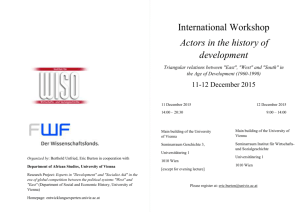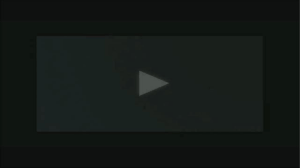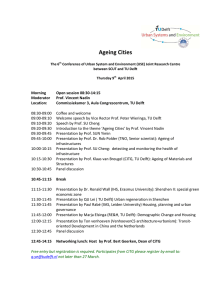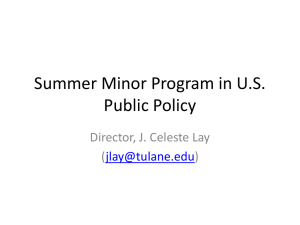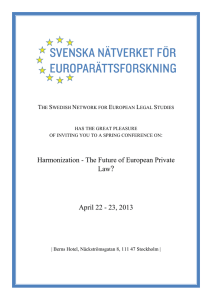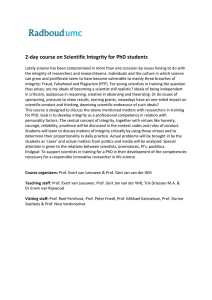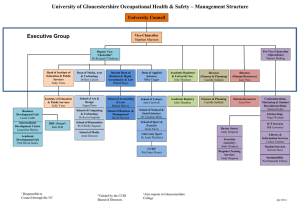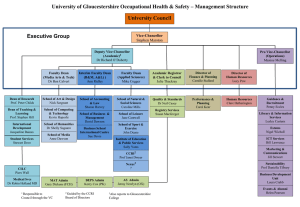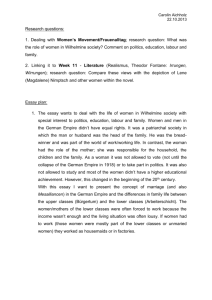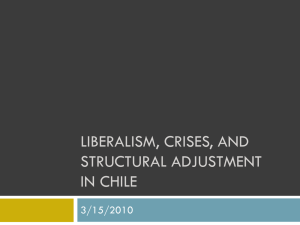Folie 1
advertisement
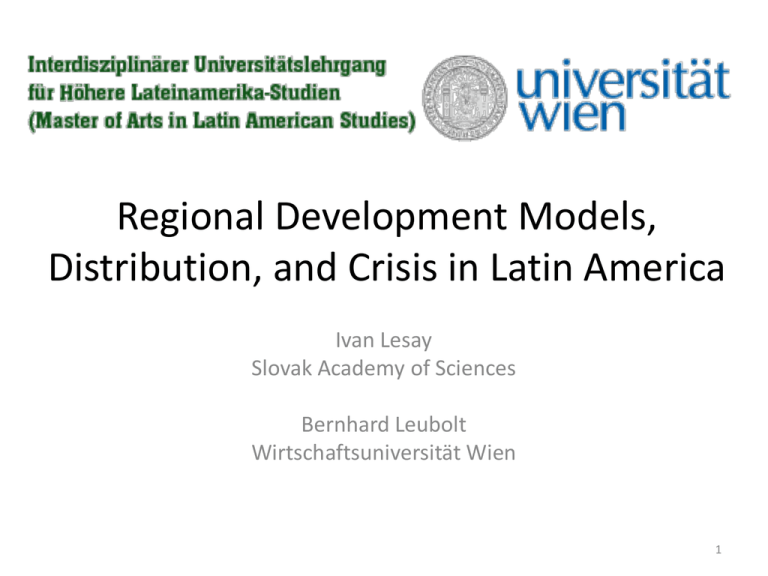
Regional Development Models, Distribution, and Crisis in Latin America Ivan Lesay Slovak Academy of Sciences Bernhard Leubolt Wirtschaftsuniversität Wien 1 Overview • • • • • • • Topics covered by the course Political Economy approach Historical background of LA ec. development Recent political and ec. Developments Lecture schedule Literature Discussion 2 Topics Covered by the Course • Regional and national models of development – Different economic structures • Industrialization • Resources – Different social structures • Social inequalities and exclusion • Impacts on formation of domestic markets – Different political projects • Variations of left-wing governments (especially in the new century) • Variations of right-wing governments – Different external policies • External trade • External politico-economic relations and blocks • Differing impacts of the global crisis 3 Approaches to understand economics and economies • Many different approaches • Political economy – Interdisciplinary understanding of economies – Economy embedded in society more than just business; social issues also relevant for economic development – Historical foundation – Internal and external influences 4 Historical Background • Since the 16th century colonisation by Spain, Portugal, France, and Great Britain – Economic structures based on raw materials exports and manufactured goods imports – Political and economic dependencies on the European colonial powers • High vulnerability to “external shocks” and changes in the world market – Social structures marked by structural heterogeneity • • • • Indigenous population either dominated or killed European “élites” as latifundistas Comprador service sector Large groups of people enslaved and/or excluded 5 Historical Background • Between the end of the 1920s and 1980s: Import-substituting industrialization (ISI) – Global economic crisis of 1920s and 1930s led to dramatic shrinking of the world market Latin American economies forced to get more self-sufficient ISI-policies – Investing into internal industrial development – Relatively high rates of economic growth until 1960s – Difficult to obtain capital to finance investments – Continuing structural heterogeneity (social exclusion) led to problems to create domestic markets – “Oil crisis” of the 1970s as the turning point • “cheap” external loans coming from oil-exporting countries debt-based intensification of ISI-policies in most countries 6 Historical Background • Crisis of ISI during the 1980s – USA raised interest rates from 1979 onwards (“Volcker Shock”) flexible interest rates on external loans in LA interest payments skyrocketed – Debt crisis in the 1980s “lost decade” economic stagnation, hyper-inflation • Neoliberalism (Washington Consensus) as a response to the crisis – Privatisations, Liberalisation and Deregulation of markets – Strong focus on the “macro-economic stability” – especially on inflation targeting – Focus rather on exports than on domestic market development 7 Recent Developments • Symptoms of a crisis of neoliberalism (Washinton Consensus) from 1990s onwards – Constantly lower rates of economic growth, increasing number of financial crises economic crisis – Rising unemployment and “informal sectors” rising rates of poverty and inequality social crisis – Environmental degradation as a result of extractivism, associated with model of export promotion environmental crisis 8 Recent Developments • Different political answers to the crisis of neoliberalism in the beginning 21st century – Continuation of neoliberalism, conservative, or “rightwing” politics: e.g. Columbia, Mexico,... – New wave of “left-wing” governments, beginning with election of Chávez in 1998: Venezuela, Bolivia, Ecuador,... – “Centre-left” governments, following the election of Lula in 2003: Brazil, Uruguay, Argentina,... • Question, in how far “post-neoliberal” models of economic development are emerging Is there a “Post-Washington Consensus” and how does it look like? 9 Recent Developments • Different models of regional integration – Neoliberal tendencies towards trade liberalization and free trade agreements including the USA (e.g. NAFTA, bilateral agreements, ALCA) – New tendencies towards pan-Latin-American or South American integration (ALBA, UNASUR, renewed MERCOSUR) • Different impacts of the current global economic crisis – Countries highly dependent on the USA and/or Europe heavily hit by the crisis (Mexico, most Central American countries) – Most South American countries hardly hit by the crisis (Brazil, Argentina, Uruguay,...) 10 Lecture Schedule 6.10. Introduction Ivan Lesay, Bernhard Leubolt 13.10. Regionale und nationale Entwicklungsmodelle in Lateinamerika und ihre Beziehung zur Weltwirtschaft Johannes Jäger (Prof. FH bfi Wien) 20.10. Lateinamerikas Sozialstrukturen im historischen Kontext Dieter Boris (Prof.em. Uni Marburg) 27.10. Lateinamerika und die globale Krise: Verwundbarkeiten, Dynamiken, Gegenstrategien Joachim Becker (Ao. Prof. Uni Wien) 11 Lecture Schedule 3.11. Transformaciones recientes en las Laura Tavares Soares políticas sociales y efectos sobre la (Prof. Universidade Federal estructura social en América Latina do Rio de Janeiro – UFRJ) 10.11. Strategien der Inwertsetzung von Ressourcen in Lateinamerika am Ende des fossilen Zeitalters Elmar Altvater (Prof. em. Berlin) 17.11. Widersprüche des brasilianischen Entwicklungsstaats Andreas Novy (Ao. Prof. WU-Wien) 24.11. Krise ohne Ende. 30 Jahre Neoliberalismus in Mexiko Stefan Pimmer (JKU Linz) 12 Lecture Schedule 1.12. Venezuela: the development of an oil-dependent country after the crisis Ilona Švihlíková (Prag) 15.12. Eine demokratische Wende für die Indigenen? Neue politische Kräfteverhältnisse und die Reichweite der wirtschaftspolitischen Transformationen in Bolivien State continuity, transformismo and neoliberal civil society formation in Chile Overview of the preceeding lectures and outlook Final exam Isabella Radhuber (La Paz / Wien) 12.1. 19.1. 26.1. Karin Fischer (JKU Linz) Ivan Lesay, Bernhard Leubolt 13 Literature • Texts related to the lectures will be available as an edited volume in the course of the semester (presumably in November): Lesay/Leubolt (eds., 2011): Lateinamerika nach der Krise: Entwicklungsmodelle und Verteilungsfragen. Wien: LIT 14


